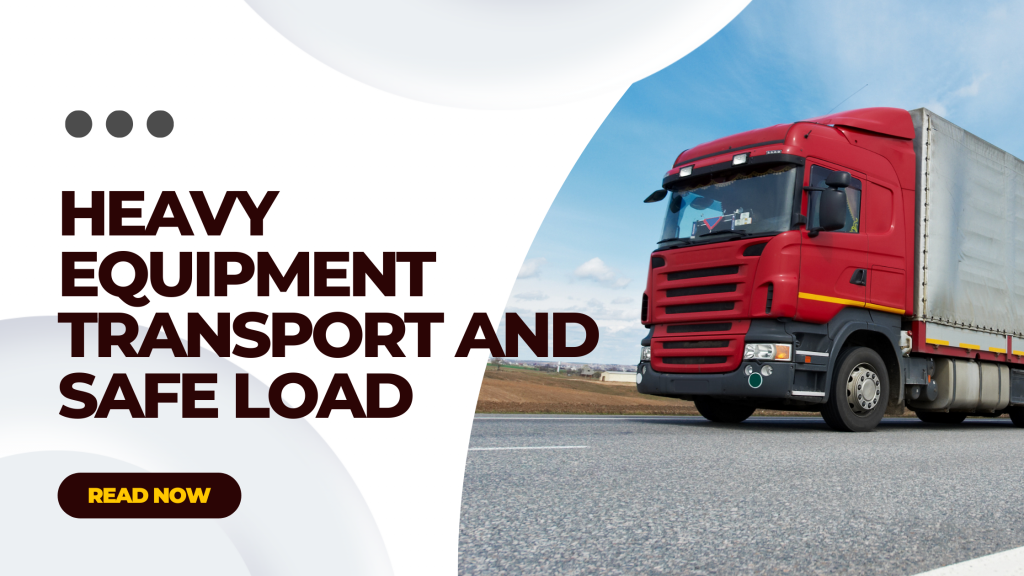Heavy Equipment Transport and Safe Load
1. Risk Assessment
When it comes to heavy equipment liability, construction companies bear the responsibility of dotting their i’s and crossing their t’s. Risk assessments are preemptive compliance documents allowing you to prove how detailed and thorough your fleet management processes are.
Consider adding one for your equipment transportation preparation protocol. They can be done by a senior manager or supervisor, containing the full operation and transportation timeline and its weight loads, plus relevant project risks and what’s been done to address them.

Heavy Equipment Transport and Safe Load
2. PPE – Protective Clothes
We can’t say it enough — safety is the backbone of the industry. Having your crew wear a complete set of personal protective equipment is a safety standard across all construction operations, not just when preparing for safe & legal transport of heavy cargo. It’s also something routinely overlooked, with many sites taking shortcuts to chain up a trailer quickly and move on to the next task.
PPE documentation is also a risk-mitigation strategy. You’ll round out a stronger risk assessment and permit application when you note all the safety protocols you and your crew adhere to on top of routine tie-down requirements for heavy equipment.
3. Inspect the Hauling Capacities of Your Truck or Trailor
Next in line when preparing for heavy equipment transport is to check the things that’ll be doing the actual transporting. A complete inspection of your trailer or truck includes the following:
Tires:
Lights:
Brakes:
Tie-Down Points:
Weight:
Any machine with attachments or appendages must have those attachments dislodged and separately secured, meaning now a minimum of five tie-down points. A typical example of this is when securely transporting excavators.
HOW TO LOAD HEAVY EQUIPMENT SAFELY
A load is only as strong as its weakest link. And those weak links often come not because a basic heavy equipment loading procedure wasn’t followed, but because it was — just in a rushed, halfhearted, or passive way.
Loading heavy equipment safely is not just about driving a new dozer up the ramp, looping in a few chains, and sending it on its way. We’ve got a few more points of consideration to ensure you reliably and legally transport heavy cargo. Refer to these safety measures for secure loading operations.
1. Designate Duties
Before actual loading occurs, the team should clearly understand who’s in charge of what. You’ll need someone to drive the equipment onto the deck, but you’ll also need a spotter to deliver hand signals and direct the driver up the ramp and onto the trailer bed. It’s likely they won’t have a clear line of site to do so themselves.
What’s more, the rest of the crew should be notified if a loading procedure is on the docket. No drifting personnel or other vehicles should interrupt loading operations, which are generally unsafe to stop once they have started.
2. Clean the Ramp and Trailer
Ramps and trailer decks should be as dirt-, oil-, and debris-free as possible, especially if they are metal. This ensures the piece of loading equipment has as much traction as possible to move up its ramp. A clean ramp and trailer bed also means a dry one, clear of ice, snow, and water. If you are still concerned about equipment smoothly moving up ramps, consider employing ramp friction devices during this step.
3. Clear and Level the Loading Area
Pick an uninhabited and even space to set up the ramp and perform heavy equipment loading. Again, this is intuitive, but in the midst of a busy workday or at peak hours in the yard, such measures can fall to the wayside.
You’ll also want to ensure the actual ground in the loading area is compact enough to bear the full weight of your loaded trailer. After rain or during seasons with thaw, the combined weight of these two vehicles has the potential to cause sinkage.
4. Begin the Machine/Ramp Line-Up
Slow and steady is the name of the game here. With the driver in the cab and a spotter positioned in plain view, begin driving the heavy equipment up the cleared ramp and onto the transportation vehicle’s deck.
Note that during this ramp movement, the machine’s center of gravity will shift. This is the most dangerous part of the loading process, with the equipment’s weight caught momentarily in a point of limbo. Just keep moving gradually.
Also note that when appropriately positioned at final rest on deck, the majority of the equipment’s weight should be distributed toward the front of the trailer. This avoids fishtailing while en route.
5. Start Chaining Down Heavy Equipment
Check state laws on how heavy equipment must be secured during public highway transportation. While the 4-5 tie down points is near-universal, each state has additional oversized cargo restrictions and regulations to respect.
With the heavy equipment safely positioned on deck, you can initiate one of the most critical steps in the loading and unloading procedure — tying it down.
HOW TO TRANSPORT HEAVY EQUIPMENT SAFELY
Vehicle accidents due to heavy trucks and cargo transport are on the rise. This merely reinforces how vital it is to not only follow proper loading and unloading procedures in the yard but also safely haul that equipment while on the road. We’ve got a few strategies.
1. Map the Most Linear Transport Route Ahead of Time
We’ve all heard the horror stories and seen the videos of trucks too tall to clear an overpass. A designated transport route planned ahead of time — plus an actual on-the-road run-through — ensures nightmares like this don’t strike.
Keep an eye out for road widths and bridges analysis for the safest heavy cargo transportation, especially in rural areas. The least amount of bridges, turns, starts, stops, and difficult terrain encountered by the driver, the better.
2. Apply for a Transportation Permit
This is especially important if your load qualifies as oversized or overwidth, which — let’s face it — most heavy construction equipment will. Cranes, excavators, dump trucks, graders, dozers, and scrapers are just a few that carry extra heavy equipment liability. Prepare accordingly, whether that means deconstructed transport strategies that avoid overwidth or overweight designations or applying for the proper state permit from the onset.
3. Immobilize Equipment Wheel Components
It takes a little extra time, but the security is worth it. Apply the equipment’s parking brake. Also consider using wedges, chocks, or cradles against equipment wheels, securing them in place and preventing them from rolling on deck. They will also bolster your defenses against the following weight-distribution forces that naturally occur during transport:
4. Outfit Transport Vehicles With Signs and Flashing Lights
Oversize loads are designated on the road with proper banners, signs, and lights. In the most extreme cases, you may be required to have escort vehicles — one guiding your own transportation truck and the other following behind, alerting others on to the road to the technical operation.
It’s also important to note that proper communications between transport and escort vehicles do not mean by cell phone. Two-way or CB radios are the industry standard for safe communication between drivers.
5. Run and Document Complaint Inspections While En Route
The safe and legal transport of heavy cargo doesn’t stop once you start the ignition. Heavy load securement requires check-ins and inspections while on the road, especially when traveling long distances.
Industry safety standards recommend the following as inspection benchmarks while heavy cargo is en route:
HOW TO SAFELY UNLOAD HEAVY EQUIPMENT
4-safely
Safely unloading construction equipment rounds out the compliant transportation process. As with other protocols, there are key steps and risk-mitigation strategies to assure the success of this final step.
1. Clear and Level the Unloading Site
Before the transportation vehicle even arrives, take the time to review and clear the designated unloading area in the receiving yard. Just as you pay attention to this during the loading phase, wet and muddy ramps and uneven unloading ground make this part of the operation much harder than necessary.
This doesn’t stop at clearing away dirt and debris, either. Alert personnel of cargo schedules so only relevant crew members are in the area when the transport vehicle arrives.
2. Do a Walk-Through
Guide the transport vehicle to its exact unloading area. Once the vehicle is parked, have the ramp clean and ready for deployment. Line it up with the rear of the trailer bed as methodically as possible, taking time to match joints and eliminate any gaps between the trailer and the ramp. Once the machinery begins backing up later on, there will be no time to reposition.
With everything in place, conduct a final condition survey. Look over the equipment’s tires and hitches to ensure their health. Review roles with personnel, appointing a spotter and an equipment operator just like during the loading process and before you begin breaking down the chain tie points. You’ll also want to do a brief survey on the condition of the tie downs themselves before their release. It is highly unsafe to undo straps and chains if the load has shifted, even minutely. If this is the case after performing a walk-through, you and the operators will have to draw up a custom unloading plan.
And remember — try not to rush this review, even if everything seems in place. It never hurt any fleet supervisor’s reputation to be methodical.
3. Free the Load
Unleash chains and tie bounds one at a time, beginning with the rear corners. Unravel excess chain that may have been wrapped around the links, then start loosening tie-downs with their ratchet-style wrench boomers. Do so carefully, as chains and binders have been wound and should still be tight and pressurized. You don’t want a metal chain unexpectedly snapping up because joints and tension weren’t adequately reduced with the ratchet boomer.
4. Slowly Back the Heavy Equipment Down the Ramp
Maintain a safe distance between the piece of equipment and its spotter. The equipment operator’s visibility may become hindered, so position the spotter in a way where they’re accessible but out of harm’s way. Keep the rest of personnel away from the unloading site while the heavy machinery is in reverse. All attention should remain on safely ushering it down the ramp.
5. Wrap It Up
Do a final ground inspection of all equipment, the transport vehicle, anchor points, and tools before sending everyone on their way. Document the conclusion of the transport — and pat yourself on the back for successfully completing the safe and legal transport of heavy cargo.


